|
|
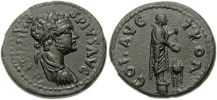
Alexandreia (AD 198-217) AE 25 - Caracalla721 viewsCaracalla, 198-217 AD. AE25 (8.15g). Laureate, draped, and cuirassed bust right / Apollo standing right sacrificing out of patera over lighted altar. EF, black patina. Rare and attractive. Marc Melcher Coll.    
(9 votes)
|
|
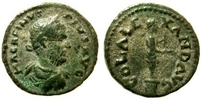
Alexandreia (AD 217-218) AE 20 - Macrinus557 viewsMacrinus, 217-218 AD. AE20 (5.26g). Laureate, draped and cuirassed bust right, seen from behind / Statue of Apollo Smintheus right on cippus, holding bow and patera. Rare. VF.    
(5 votes)
|
|
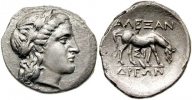
Alexandreia (BC 300-200) Stater2010 viewsca 3rd cent BC. AR Stater (10.62g). Laureate head of Apollo right / ΑΛΕΞΑÎ-ΔΡΕΩÎ, horse grazing right; ΣΙ below. Good VF, traces of undertype visible on reverse. Unpublished and unique.
The earliest coins of Alexandria are bronze issues struck about 300 BC imitating Hamaxitus (Apollo Smitheus) and Hamandria (Apollo/horse feeding). The earliest silver attributable to Alexandria are tetradrachms ca 280-275 in the name of Alexander, which on grounds of style belong to the years after the death of Lysimachus (Price 1588-1590). During the Second Syrian War (260-253) Antiochus II produced an issue of tetradrachms (SNG Spaer 374-376). Another two issues in the name of Alexander followed ca 230 (Price 1591), and again in 189-180 (Price 1592-1598). At some point during the 3rd century BC, an extensive bronze issue was produced (BMC 7-21), to which this previously unknown silver stater belongs, based on the local Persian silver weight standard, obviously intended for local use.    
(6 votes)
|
|
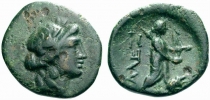
Alexandreia (BC 301-281) AE 141194 viewsca 301-281 BC. AE14 (1.89g). Laureate head of Apollo right / Apollo Smintheos standing right, wearing long garb, holding bow with both hands, case on back; ΑΛΕΞ to left, mouse at feet to right. Dark green patina, gVF. Rare. Gutknecht coll.    
(5 votes)
|
|
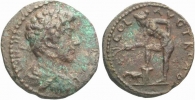
Alexandreia (AD 180-192) AE 25 - Commodus754 viewsCommodus, 180-192 AD. AE25 (6.44g). Draped, cuirassed and laureate bust right / COL - AVG TROAD, naked Apollo Smintheus standing left, bent with right foot on basis, holding branch in right hand, left hand on hip; bird standing left at feet. Brown patina with light green highlights on obv., VF/gVF. Rare.    
(10 votes)
|
|
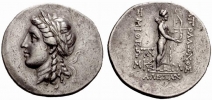
Alexandreia (BC 171Â-65) Tetradrachm1168 viewsca 171 BC. AR Tetradrachm (16.94g, 34mm). Laureate head of Apollo left / ΑΠΟΛΛΩÎΟΣ ZΜΙΘΕΩΣ, Apollo Smintheus standing right, quiver over shoulder, holding bow and arrow in left hand, patera in right; two monograms to left, PΛ (130) to right, ΑΛΕΞΑΠin exergue. gVF. Extremely rare, apparently unique, unpublished year.
The dating of the coins of Alexandria Troas starts from the foundation of the city (300 BC), shown on the reverse of the coins. The first known issue to date was 164 BC (137 year after foundation). This coin records a date of 130 years after the city foundation, seven years prior to the first known issue.    
(8 votes)
|
|
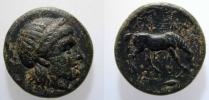
Alexandreia (BC 300) AE 20824 viewsca 300 BC. AE20 (7.88g) Laureate head of Apollo right / horse grazing right, ΑΛΕΞΑÎ-ΔΡΕΩΠabove and below, ΙΣ monogram and corn grain below.    
(6 votes)
|
|
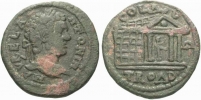
Alexandreia (AD 198-217) AE 26 - Caracalla685 viewsCaracalla, 198-217 AD. AE26 (8.20g). Laureate head right / COL A-V-G / TROAD, side view of temple of Apollo Smintheus, statue of god in middle. DArk olive-green patina with red marks, VF.    
(8 votes)
|
|
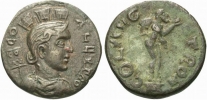
Alexandreia (AD 250-268) AE 22588 viewsQuasi-autonomous, ca 250-268 AD. AE22 (6.57g). AL-EX TRO, Draped bust of turreted Alexandria right, vexillum with CO/AV / COL AVG - TROA, naked Marsyas standing right, carrying wine bag over left shoulder, right hand raised. gVF/VF.    
(9 votes)
|
|
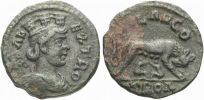
Alexandreia (AD 250-268) AE 21802 viewsQuasi-autonomous, ca 250-268 AD. AE21 (5.24g). AL-EX TRO, Draped bust of turreted Alexandria right, vexillum with CO/AV / COL AVG O/TROA, Roman wolf feeding twins right. Dark green patina, gVF.    
(10 votes)
|
|
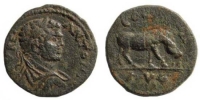
Alexandreia (AD 198-217) AE 23 - Caracalla1881 viewsCaracalla, 198-217 AD. AE23 (5.83g). Laureate and draped bust right / Horse grazing right on ground line. Dark patina, good fine.    
(10 votes)
|
|
|
|
|
